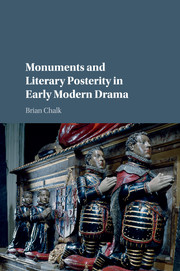Book contents
- Monuments and Literary Posterity in Early Modern Drama
- Monuments and Literary Posterity in Early Modern Drama
- Copyright page
- Dedication
- Contents
- Figures
- Book part
- Introduction: “raptures of futurity”
- Chapter 1 “Let All things End”
- Chapter 2 Jonson'stextual monument
- Chapter 3 Webster's“worthyest monument”
- Chapter 4 “Mocking life”
- Chapter 5 Fletcher'sfuture
- Coda: what they hath left us
- Select bibliography
- Index
- References
Select bibliography
Published online by Cambridge University Press: 05 November 2015
- Monuments and Literary Posterity in Early Modern Drama
- Monuments and Literary Posterity in Early Modern Drama
- Copyright page
- Dedication
- Contents
- Figures
- Book part
- Introduction: “raptures of futurity”
- Chapter 1 “Let All things End”
- Chapter 2 Jonson'stextual monument
- Chapter 3 Webster's“worthyest monument”
- Chapter 4 “Mocking life”
- Chapter 5 Fletcher'sfuture
- Coda: what they hath left us
- Select bibliography
- Index
- References
- Type
- Chapter
- Information
- Monuments and Literary Posterity in Early Modern Drama , pp. 210 - 219Publisher: Cambridge University PressPrint publication year: 2015

